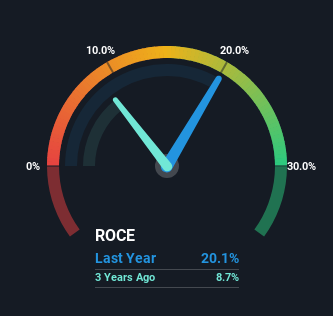We Like Lungteh Shipbuilding's (TWSE:6753) Returns And Here's How They're Trending

What are the early trends we should look for to identify a stock that could multiply in value over the long term? Firstly, we'd want to identify a growing return on capital employed (ROCE) and then alongside that, an ever-increasing base of capital employed. If you see this, it typically means it's a company with a great business model and plenty of profitable reinvestment opportunities. With that in mind, the ROCE of Lungteh Shipbuilding (TWSE:6753) looks great, so lets see what the trend can tell us.
What Is Return On Capital Employed (ROCE)?
If you haven't worked with ROCE before, it measures the 'return' (pre-tax profit) a company generates from capital employed in its business. Analysts use this formula to calculate it for Lungteh Shipbuilding:
Return on Capital Employed = Earnings Before Interest and Tax (EBIT) ÷ (Total Assets - Current Liabilities)
0.20 = NT$930m ÷ (NT$8.8b - NT$4.2b) (Based on the trailing twelve months to March 2024).
So, Lungteh Shipbuilding has an ROCE of 20%. That's a fantastic return and not only that, it outpaces the average of 8.4% earned by companies in a similar industry.
View our latest analysis for Lungteh Shipbuilding

Historical performance is a great place to start when researching a stock so above you can see the gauge for Lungteh Shipbuilding's ROCE against it's prior returns. If you want to delve into the historical earnings , check out these free graphs detailing revenue and cash flow performance of Lungteh Shipbuilding.
The Trend Of ROCE
The trends we've noticed at Lungteh Shipbuilding are quite reassuring. The numbers show that in the last five years, the returns generated on capital employed have grown considerably to 20%. The amount of capital employed has increased too, by 347%. The increasing returns on a growing amount of capital is common amongst multi-baggers and that's why we're impressed.
Another thing to note, Lungteh Shipbuilding has a high ratio of current liabilities to total assets of 47%. This can bring about some risks because the company is basically operating with a rather large reliance on its suppliers or other sorts of short-term creditors. While it's not necessarily a bad thing, it can be beneficial if this ratio is lower.
What We Can Learn From Lungteh Shipbuilding's ROCE
All in all, it's terrific to see that Lungteh Shipbuilding is reaping the rewards from prior investments and is growing its capital base. Since the stock has returned a staggering 337% to shareholders over the last three years, it looks like investors are recognizing these changes. Therefore, we think it would be worth your time to check if these trends are going to continue.
Lungteh Shipbuilding does have some risks though, and we've spotted 1 warning sign for Lungteh Shipbuilding that you might be interested in.
If you want to search for more stocks that have been earning high returns, check out this free list of stocks with solid balance sheets that are also earning high returns on equity.
If you're looking to trade Lungteh Shipbuilding, open an account with the lowest-cost platform trusted by professionals, Interactive Brokers.
With clients in over 200 countries and territories, and access to 160 markets, IBKR lets you trade stocks, options, futures, forex, bonds and funds from a single integrated account.
Enjoy no hidden fees, no account minimums, and FX conversion rates as low as 0.03%, far better than what most brokers offer.
Sponsored ContentNew: AI Stock Screener & Alerts
Our new AI Stock Screener scans the market every day to uncover opportunities.
• Dividend Powerhouses (3%+ Yield)
• Undervalued Small Caps with Insider Buying
• High growth Tech and AI Companies
Or build your own from over 50 metrics.
Have feedback on this article? Concerned about the content? Get in touch with us directly. Alternatively, email editorial-team (at) simplywallst.com.
This article by Simply Wall St is general in nature. We provide commentary based on historical data and analyst forecasts only using an unbiased methodology and our articles are not intended to be financial advice. It does not constitute a recommendation to buy or sell any stock, and does not take account of your objectives, or your financial situation. We aim to bring you long-term focused analysis driven by fundamental data. Note that our analysis may not factor in the latest price-sensitive company announcements or qualitative material. Simply Wall St has no position in any stocks mentioned.
About TWSE:6753
Excellent balance sheet with acceptable track record.
Similar Companies
Market Insights
Community Narratives




